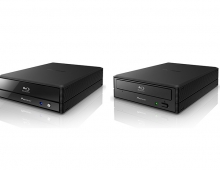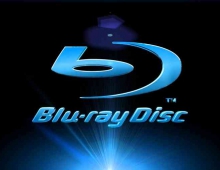
Hollywood Partially Neglects MPEG-4 For HD Titles
As Hollywood readies its new and high-definition DVDs, some studios are refusing to deliver their content encoded with the new MPEG-4 codecs, sticking with the MPEG-2 instead.
Last week, Sony Pictures voting against the use of either Microsoft's VC-1, or the rival AVC in its forthcoming HD movies. The new advanced codecs aren't immediately necessary for discs released in Sony's high-capacity Blu-ray format, Sony Pictures executives said in an interview with CNET News.com, and the studio would instead use the 11-year-old MPEG-2 video codec used on today's DVDs.
Using the MPEG-2 codec would not afect the picture quality of the HD movies, but it would be reasonable to use a more efficient and equaly performer instead, based on the MPEG-4 specifications. After all, squeezing audio or video into smaller packages is more convenient for storage or transmission. Although they don't necessarily make a picture clearer, they allow roughly the same picture quality to be created using only about half the digital storage space. But don't forget that using MPEG-4 could possibly allow storing of HD content on current double-layer DVD media, without needing to migrate to the expensive HD DVD or Blu-Ray formats, in most cases at least.
The MPEG-4 AVC standard was finalized by the MPEG group and is also known as H.264 or Advanced Video Coding.
VC-1 The version of Microsoft's Windows Media 9 video codec submitted to industry standards bodies for use on DVDs and elsewhere. it was temporarily known as VC-9.
"Advanced (formats) don't necessarily improve picture quality," said Don Eklund, Sony Pictures' senior vice president of advanced technology. "Our goal is to present the best picture quality for Blu-ray. Right now, and for the foreseeable future, that's with MPEG-2."
Sony's decision could mean a great deal to companies that have invested heavily in creating or supporting the new video technologies. Microsoft has been betting that the adoption of its advanced video format by Hollywood studios, cable networks and satellite TV companies will help Windows-based devices capture a bigger share of the home entertainment market.
The studio's decision represents a setback for the advanced codecs and their backers--an even greater one if other studios such as Disney, Paramount or Universal Pictures decide to follow Sony's lead, as some industry indsiders predict. And that could happen, particularly in the early days of the new DVDs, when the new codecs are unfamiliar to producers and engineers who have to create the DVD files, some analysts say. Hollywood production staff know how to make a clean DVD picture using the old technology, while the newer formats remain relatively unexplored territory.
But so far, studios remain split.
Another reason for using the MPEG-2 codecs is the fact that it requires less CPU power during playback and encoding, when it reaches the PC platform. The MPEG4-based codecs require significantly more CPU power as well as GPU (Graphics Procession Unit) power contributed by high-end graphics cards.
Representatives for Warner Bros. and 20th Century Fox said they were planning to use the new formats. Warner is leaning toward Microsoft's VC-1 format, while Fox is leaning towards the AVC format, the studios said.
Warner has agreed to release movies in Sony's Blu-ray format next year, and plans to use a modified disc that is actually constructed more like an old DVD and is cheaper to produce, holding about 9 gigabytes instead of the standard 25 gigabyte disc that Sony Pictures and other studios will use. That could mean cheaper prices for consumers, if the savings in manufacturing costs are passed along.
Nine gigabytes is not nearly enough space to hold a high-definition movie and extras using the old MPEG-2 format. But it will be enough space for a movie encoded with Microsoft's VC-1, or the rival AVC.
Most of Hollywood to move to the advanced codecs over time, too, as studios adapt to the new production tools, and start putting even more high-definition content on discs to set them apart from their DVD predecessors.
But Sony Pictures made it clear that day is still a ways off.
"We're really trying to set this apart from DVD," Eklund said. "Sony Pictures' belief is that in order to launch the HD format, it should be done without compromises."
Using the MPEG-2 codec would not afect the picture quality of the HD movies, but it would be reasonable to use a more efficient and equaly performer instead, based on the MPEG-4 specifications. After all, squeezing audio or video into smaller packages is more convenient for storage or transmission. Although they don't necessarily make a picture clearer, they allow roughly the same picture quality to be created using only about half the digital storage space. But don't forget that using MPEG-4 could possibly allow storing of HD content on current double-layer DVD media, without needing to migrate to the expensive HD DVD or Blu-Ray formats, in most cases at least.
The MPEG-4 AVC standard was finalized by the MPEG group and is also known as H.264 or Advanced Video Coding.
VC-1 The version of Microsoft's Windows Media 9 video codec submitted to industry standards bodies for use on DVDs and elsewhere. it was temporarily known as VC-9.
"Advanced (formats) don't necessarily improve picture quality," said Don Eklund, Sony Pictures' senior vice president of advanced technology. "Our goal is to present the best picture quality for Blu-ray. Right now, and for the foreseeable future, that's with MPEG-2."
Sony's decision could mean a great deal to companies that have invested heavily in creating or supporting the new video technologies. Microsoft has been betting that the adoption of its advanced video format by Hollywood studios, cable networks and satellite TV companies will help Windows-based devices capture a bigger share of the home entertainment market.
The studio's decision represents a setback for the advanced codecs and their backers--an even greater one if other studios such as Disney, Paramount or Universal Pictures decide to follow Sony's lead, as some industry indsiders predict. And that could happen, particularly in the early days of the new DVDs, when the new codecs are unfamiliar to producers and engineers who have to create the DVD files, some analysts say. Hollywood production staff know how to make a clean DVD picture using the old technology, while the newer formats remain relatively unexplored territory.
But so far, studios remain split.
Another reason for using the MPEG-2 codecs is the fact that it requires less CPU power during playback and encoding, when it reaches the PC platform. The MPEG4-based codecs require significantly more CPU power as well as GPU (Graphics Procession Unit) power contributed by high-end graphics cards.
Representatives for Warner Bros. and 20th Century Fox said they were planning to use the new formats. Warner is leaning toward Microsoft's VC-1 format, while Fox is leaning towards the AVC format, the studios said.
Warner has agreed to release movies in Sony's Blu-ray format next year, and plans to use a modified disc that is actually constructed more like an old DVD and is cheaper to produce, holding about 9 gigabytes instead of the standard 25 gigabyte disc that Sony Pictures and other studios will use. That could mean cheaper prices for consumers, if the savings in manufacturing costs are passed along.
Nine gigabytes is not nearly enough space to hold a high-definition movie and extras using the old MPEG-2 format. But it will be enough space for a movie encoded with Microsoft's VC-1, or the rival AVC.
Most of Hollywood to move to the advanced codecs over time, too, as studios adapt to the new production tools, and start putting even more high-definition content on discs to set them apart from their DVD predecessors.
But Sony Pictures made it clear that day is still a ways off.
"We're really trying to set this apart from DVD," Eklund said. "Sony Pictures' belief is that in order to launch the HD format, it should be done without compromises."





















